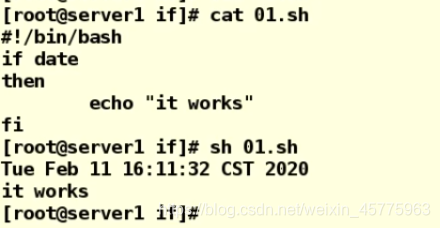shell中的if语句
1. if语句的基本格式
if condition #如果满足condition条件
then
statement(s) #就执行statement(可以有多个)
fi
注意:这里的then和if可以位于一行,位于一行时condition后要加分号:
if condition;then
statement
fi
例1:
#!/bin/bash
if date #如果能够正常执行date命令
then
echo "it works" #就输出it works
fi #date命令的执行结果也会被输出

例2:
#!/bin/bash
if datfff #如果能够正常执行datefff命令
then
echo "it works" #就输出it works
fi #如果不能执行datefff,就跳出if语句,执行下面的内容
echo "we are outside if the if statement"

例3:
#!/bin/bash
testing=student
if grep $testing /etc/passwd
then
echo The bash files for user $testing are:
ls -a /home/$testing/.b*
fi

例4:
#!/bin/bash
read a
read b
if (( $a == $b ))
then
echo "a和b相等"
fi

例5:
#!/bin/bash
read num1
read num2
if (( $num1 >18 && $num2 < 60 ))
then
echo $num1
echo $num2
fi

2. if-else语句
如果语句有两个分支,就可以使用if-else语句
格式:
if condition
then
statement1
else
statement2
fi
如果condition成立,那么then后面的statement1将会被执行;
否则,执行else后面的statement2语句
例:
#!/bin/bash
read a
read b
if (( $a == $b ))
then
echo "a和b相等"
else
echo "a和b不相等"
fi

3. if-elif-else语句
shell支持任意数目的分支,当分支比较多时,可以使用if elif else 结构
格式:
if condition1
then
statement1
elif condition2
then
statement2
elif condition3
then
statement3
......
else
statementn
fi
注意:if和eilf后面后要跟then
整条语句的执行逻辑为:
如果condition1成立,那么就执行if后面的statement1;如果condition1不成立,就继续执行elif,判断condition2;
如果condition2成立,那么就执行if后面的statement2;如果condition2不成立,就继续执行elif,判断condition3;
以此类推…
如果所有的if和elif判断都不成立,就进入最后的else,执行statementn。
例:
#!/bin/bash
read age
if (($age<=2));then
echo "婴儿"
elif (($age>=3 && $age<=8));then
echo "幼儿"
elif (($age>=9 && $age<=17));then
echo "少年"
elif (($age>=18 && $age<=25));then
echo "成年"
elif (($age>=26 && $age<=40));then
echo "青年"
elif (($age>=41 && $age<=60));then
echo "中年"
else
echo "老年"
fi

来源:CSDN
作者:Kaiser king
链接:https://blog.csdn.net/weixin_45775963/article/details/104312231